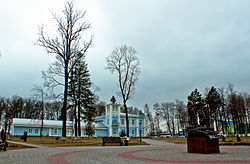Khoyniki
Khoiniki
Town in Gomel Region, Belarus
Khoiniki (Belarusian: Хойнікі, romanized: Chojniki, IPA: [ˈxɔɪ̯n̪ʲikʲi]; Russian: Хойники, romanized: Khoyniki; Polish: Chojniki) is a town in Gomel Region, Belarus.[2] It serves as the administrative center of Khoiniki District.[2][1] As of 2024, it has a population of 13,167.[1]
This article needs additional citations for verification. (January 2021) |
You can help expand this article with text translated from the corresponding article in Belarusian. (February 2024) Click [show] for important translation instructions.
|
In 1986, the area around Khoiniki experienced heavy radioactive fallout from the Chernobyl accident; however, the city itself was not significantly affected. Today, the town hosts the headquarters of Polesie State Radioecological Reserve and employs over 700 people. The reserve itself is located south of the town in a heavily contaminated area.



